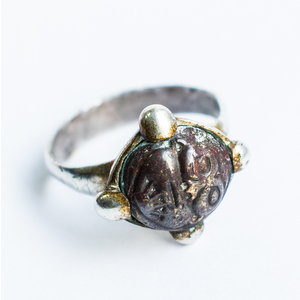On Wednesday, October 30, the visit of Russian President Vladimir Putin to Budapest took place. The official delegation of the Russian Federation included Governor of the Samara Region Dmitry Azarov.
The Head of the Samara Region met with President of Győr-Moson-Sopron County Zoltán Németh (Hungary). At the meeting the topic of joint scientific research in the field of archeology of Pázmány Péter Catholic University and Samara National Research University scientists was touched upon. Dmitry Azarov gave Zoltán Németh an exact copy of the ancient Magyar ring found by the archaeologists of Samara University during excavations in the Borsky district of the Samara Region. The scientists attribute the find to the 9th century. According to their opinion, the ring could have belonged to a prominent Magyar warrior or a military leader.
A copy of the ring was made in Samara University Laboratory of Additive Technologies, and the original, stored in the local museum, has recently become an exhibit of the virtual archaeological museum, a project of which was developed by the archaeologists and programmers of the university. The staff of the Department of Supercomputers and General Informatics digitized the ring and placed its virtual 3D model into the Magyar Hall of the museum, dedicated to the location of the Hungarian ancestral homeland and the history of ancient Magyars in the Samara Volga Region. Earlier scientists suggested that the ancient Magyars originally lived in the Northern Black Sea Region. The origin of the Magyars, as well as the location of their historical ancestral homeland, is still interpreted differently by various scholars due to the extremely small number of available sources. The Magyar burial grounds found in the Samara Region suggest the version that the ancestral homeland of modern Hungarians could be in the Samara Trans-Volga Region.
“We can say that the Hungarians are closer to us than we thought before”, – said Sergey Zubov, Director of the Research and Education Centre for Archaeology and Ethnography, Head of Samara University Research Laboratory of Archaeology.
The findings of Samara scientists are based on various artifacts found in the burials – weapons, items of clothing, household items, and jewelry of ancient Magyars. The first finds were discovered almost half a century ago. "In the 70s of the XX century, at the Nemchanka junction in the Borsky district, the first two burials belonging to the Magyar circle were found", – said Zubov. Distinctive Ugric ornaments riveted to the military belt characterize this people. Since then a dozen and a half of burial grounds have been found. There are few artifacts in them, but at the same time they clearly mark the movement of the Hungarians across the territory of the Samara Region. The collection of Samara University archaeologists, being systematically created from the 70s of the 20th century to the present, has become the basis for a virtual museum. The finds are digitized by the specialists of Samara University Department of Supercomputers and General Informatics. Among the first 3D-models of the museum are axes, sabers, rings, dishes, and other household items.
For reference:
The Samara Region is actively cooperating with the regions of Hungary. In the autumn of 2018, Consul General of Hungary in Kazan Adam Stifter paid a working visit to the Samara Region. In the course of the meeting with Governor Dmitry Azarov, the agreements on the development of economic ties were reached, and the decision to hold Hungarian Film Days in the Samara Region was made.
In addition, in the summer of 2019, the joint international multidisciplinary research project “Early Magyars on the Volga” was launched as part of an agreement between Pázmány Péter Catholic University and Samara University. As part of this project, in the summer of 2019, the scientists from the University of Hungary and Samara University conducted archaeological excavations in the Stavropol District of the Samara Region.
The project is dedicated to the location of the ancestral homeland of the Hungarians and the history of the ancient Magyars. At the end of the 9th century, the Magyar tribes, having traveled from the Southern Urals and the Volga to the Carpathian Basin, chose the steppes of the Middle Danube Lowland as their place of residence. Scientists call this important for the Hungarian people historical period "The Era of Homeland Acquisition". But the location of the land that the Magyars left more than a thousand years ago still remains mysterious.
According to the treatise "On the Peoples" of the Byzantine Emperor Constantine VII Bagryanorodny, the Magyar tribes began their movement to the West from the "area called Levedia". Samara archaeologists believe that Levedia may mean the territory that was located in the Volga Region, in the lower and middle reaches of the Samara River, where several burials of the 8th-9th centuries were found. In the course of excavations archaeological materials and finds important in the historical context were discovered.
Photo: Anastasya Pohilchuk
